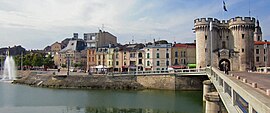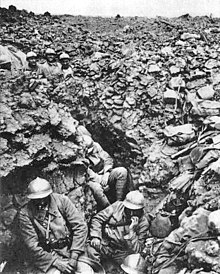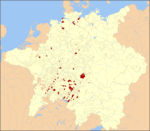Verdun
You can helpexpand this article with text translated fromthe corresponding articlein French.(April 2017)Click [show] for important translation instructions.
|
Verdun | |
|---|---|
 Verdun and the Meuse river | |
| Coordinates:49°09′43″N5°23′15″E/ 49.162°N 5.3876°E | |
| Country | France |
| Region | Grand Est |
| Department | Meuse |
| Arrondissement | Verdun |
| Canton | Verdun-1and2 |
| Intercommunality | CA Grand Verdun |
| Government | |
| • Mayor(2020–2026) | Samuel Hazard[1] |
| Area 1 | 31.03 km2(11.98 sq mi) |
| Population (2021)[2] | 16,689 |
| • Density | 540/km2(1,400/sq mi) |
| Time zone | UTC+01:00(CET) |
| • Summer (DST) | UTC+02:00(CEST) |
| INSEE/Postal code | 55545/55100 |
| Elevation | 194–330 m (636–1,083 ft) |
| 1French Land Register data, which excludes lakes, ponds, glaciers > 1 km2(0.386 sq mi or 247 acres) and river estuaries. | |
Verdun(/vɜːrˈdʌn/vur-DUN,[3]UKalso/ˈvɛərdʌn/VAIR-dun,[4]USalso/vɛərˈdʌn/vair-DUN,[5]French:[vɛʁdœ̃];official name before 1970:Verdun-sur-Meuse) is a city in theMeusedepartmentinGrand Est,northeasternFrance.It is anarrondissementof the department.
Verdun is the biggest city in Meuse, although the capital of the department isBar-le-Duc,which is slightly smaller than Verdun. It is well known for givingits name to the longest battle in modern historyin theFirst World War.
Geography[edit]
Verdun is situated on both banks of the riverMeuse,in the northern part of the Meuse department. It is connected by rail toJarny.TheA4 autorouteParis–Metz–Strasbourg passes south of the town.
History[edit]
Verdun (Verodunum,alatinisationof aplace namemeaning "strongfort"inGaulish) was founded by theGauls.[citation needed]It has been the seat of the bishop ofVerdunsince the4th century,with interruptions.[6]In 486, following the decisiveFrankishvictory at theBattle of Soissons,the city (amongst several other nearby cities) refused to yield to the Franks and was thus besieged by KingClovis I.[7]The 843Treaty of VerdundividedCharlemagne's empire among his three surviving grandsons.
Around this time a city called Verdun was the centre of the thriving European trade in young boys, who were sold to the IslamicemiratesofIberia,where they were enslaved aseunuchs.[8][page needed]The Italian ambassadorLiutprand of Cremona,as one example in the 10th century, presented a gift of four eunuchs to EmperorConstantine VII.[9]The identity of the "Verdun" mentioned in sources is disputed because there are many cities called Verdun in Europe (such asVerdun-sur-GaronneinOccitaniaandVerdun-sur-le-Doubs).[10]While many still identify it as Verdun on the Meuse, some argue thatVerdun-sur-le-Doubsis a more feasible identification. It is also possible that Liutprand was referring toVerona.[10]
Since 1200 Verdun has been famous for itsDragéesor sugared almonds; they were distributed at thebaptismof French princes.[6]
Verdun was part of the middle kingdom ofLotharingiaand in 1374 it became afree imperial cityof theHoly Roman Empire.The Bishopric of Verdun formed together with Tull (Toul) andMetztheThree Bishoprics,which were annexed by France in 1552 (recognized in 1648 by thePeace of Westphalia).
From 1624 to 1636 a largebastioned citadelwas constructed on the site of the Abbey of Saint Vanne. In 1670Sébastien Le Prestre de Vaubanvisited Verdun and drew up an ambitious scheme to fortify the whole city. Although much of his plan was carried out in the following decades, some of the elements were not completed until after theNapoleonic Wars.During the Napoleonic War the citadel was used to hold Britishprisoners of war.
In theFranco-Prussian WarVerdun was the last French fortress to surrender in 1870. Shortly afterwards a new system of fortification was begun.[11]This consisted of a mutually supporting ring of 22polygonal fortsup to 8 kilometres (5.0 mi) from the city and an inner ring of 6 forts.[12]

Battle of Verdun (1792)[edit]
Despite the extensive fortifications, in theBattle of Verdun in 1792the fortress was captured by thePrussiansduring theWar of the First Coalition.The battle was fought on 20 August 1792 between French Revolutionary forces and the Prussian army. The Prussian victory opened the path to Paris for the invading armies. However the Prussians were unable to press their success and abandoned Verdun following theBattle of Valmy.[13]
Battle of Verdun (First World War)[edit]

Verdun was the site of amajor battle,the longest-lasting of the First World War.[14]One of the costliest battles in military history, Verdun exemplified the policy of awar of attritionpursued by both sides, which led to an enormous loss of life and very long casualty lists.[15]
Following the failure of theSchlieffen Planin 1914 and the solidifying of theWestern Front,[16]Germany remained on the strategic defensive in the west throughout most of 1915.[17]In the winter of 1915–16, German GeneralErich von Falkenhayn,the chief of theGerman General Staff(1914–1916) made plans for a large offensive on the Western Front that ultimately aimed to break the French Army through the application of firepower at a point that the French had to hold for reasons of national prestige.[18]As Falkenhayn recalled it, his so-called "Christmas memorandum" toKaiser Willhelm IIenvisioned a massive but limited attack on a French position 'for the retention of which the French Command would be compelled to throw in every man they have'.[19]Once the French army had bled to death, Britain could be brought down by Germany'ssubmarineblockade and superior military strength. The logic of initiating a battle not to gain territory or a strategic position but simply to create a self-sustaining killing ground—to bleed the French army to death—pointed to the grimness of military vision in 1916.
Recent scholarship by Holger Afflerbach and others, however, has questioned the veracity of the Christmas memo. No copy has ever surfaced and the only account of it appeared in Falkenhayn's post-war memoir.[20]His army commanders at Verdun, including the German Crown Prince, denied any knowledge of an attrition strategy. It is possible that Falkenhayn did not specifically design the battle to bleed the French army but used this supposed motive after the fact in an attempt to justify the Verdun offensive, despite its failure.

Verdun was the strongest point in pre-war France, ringed by a string of powerful forts, includingDouaumontandFort Vaux.By 1916, the salient at Verdun jutted into the German lines and lay vulnerable to attack from three sides. The historic city of Verdun had been anoppidumof theGaulsbefore Roman times and later a key asset in wars againstPrussia,and Falkenhayn suspected that the French would throw as many men as necessary into its defence. Ironically, France had substantially weakened Verdun's defences after the outbreak of the war, an oversight that would contribute to the removal ofJoseph Joffrefrom supreme command at the end of 1916. The attack was slated to begin on 12 February, then 16 February, but the snow forced repeated postponements.

Falkenhayn massed over 1000 artillery pieces[21]to the north and east of Verdun to precede the infantry advance with intensive artillery bombardment. His attack would hit the French positions on the right bank of theMeuse.Although French intelligence had warned of his plans, these warnings were ignored by the French Command and troop levels in the area remained low. Consequently, Verdun was utterly unprepared for the initial bombardment on the morning of 21 February 1916. German infantry attacks followed that afternoon and met tenacious but ultimately inadequate resistance for the first four days.
On 25 February, the Germans occupied Douaumont. French reinforcements—now under the leadership of GeneralPhilippe Pétain—began to arrive and were instantly thrown into "the furnace" (as the battle was called) to slow the German advance, no matter what the cost. Over the next several days, the stubborn defense managed to slow the German advance with a series of bloody counter-attacks. In March, Falkenhayn decided to target the French positions on the left bank of the Meuse as well, broadening the offensive front twofold. Throughout March and April,Cumières-le-Mort-Hommeand Hill 304 were under continuous heavy bombardment and relentless infantry attacks. Meanwhile, Pétain organised repeated, small-scale counter-attacks to slow the German advance. He also ensured that the sole supply road fromBar-le-Ducinto Verdun remained open. It became known as theVoie Sacrée"Sacred Way" because it continued to carry vital supplies and reinforcements into the Verdun front despite constant artillery fire.

German gains continued in June, but slowly and only after increasingly heavy losses on their side. On 7 June, following almost a week of bitter resistance,Fort Vauxfell to the Germans after a murderous hand-to-hand fight inside the fort itself. On 23 June, the Germans reached what would become the furthest point of their advance. The line was just in front of Fort Souville, the last stronghold before Verdun itself. Pétain was making plans to evacuate the right bank of the Meuse when the combined Anglo-Frenchoffensive on the Somme Riverwas launched on 1 July, partly to relieve pressure on the French, although thefirst daywas the bloodiest in theBritish Army's history.The Germans could no longer afford to continue their offensive at Verdun when they were needed so desperately on the Somme. At a cost of some 400,000 German casualties and a similar number of French, the attack was finally called off. The estimated death toll on both sides were 143,000 dead Germans and 162,440 French soldiers.[21]Falkenhayn's plan to bleed France to death – if indeed that had been his intention – had failed.
The battle continued, however, from October to the end of the year. French offensives, employing new tactics devised by GeneralRobert Nivelle,regained the forts and territory they had lost earlier. This was the only gleam of hope in an otherwise abysmal landscape.
Overall, the battle lasted 11 months. Falkenhayn was replaced byPaul von Hindenburgas Chief of General Staff. General Nivelle was promoted over the head of General Pétain to replaceGeneralissimoJoseph Joffreas French supreme commander, although he was to hold the post for less than six months.
Population[edit]
|
| ||||||||||||||||||||||||||||||||||||||||||||||||||||||||||||||||||||||||||||||||||||||||||||||||||||||||||||||||||
| |||||||||||||||||||||||||||||||||||||||||||||||||||||||||||||||||||||||||||||||||||||||||||||||||||||||||||||||||||
| Source: EHESS[22]and INSEE (1968-2017)[23] | |||||||||||||||||||||||||||||||||||||||||||||||||||||||||||||||||||||||||||||||||||||||||||||||||||||||||||||||||||
Panoramic views[edit]
Cemetery and memorials[edit]
There are many French and German cemeteries throughout the battlefield. The largest is the French National Cemetery andDouaumont Ossuarynear Fort Douaumont. Thirteen thousand crosses adorn the field in front of the ossuary, which holds roughly 130,000 unidentified remains brought in from the battlefield. Every year yields more remains, which are often placed inside the ossuary's vaults.
Among many revered memorials on the battlefield is the "Bayonet Trench", which marks the location where some dozenbayonetslined up in a row were discovered projecting out of the ground after the war; below each rifle was the body of a French soldier. It has been assumed that these belonged to a group of soldiers who had rested their rifles against the parapet of the trench they were occupying when they were killed during a bombardment, and the men were buried where they lay in the trench and the rifles left untouched. However, this is probably not historically accurate: experts agree that the bayonets were probably affixed to the rifles after the attack and installed by survivors to memorialize the spot.[24]
Nearby, the World War I Meuse-Argonne American Cemetery and Memorial is located atRomagne-sous-Montfauconto the northwest of Verdun. It is the final resting place for 14,246 American military dead, most of whom died in theMeuse-Argonne Offensive.The chapel contains a memorial to the 954 American missing whose remains were never recovered or identified.
On 12 September 1916King George Vawarded theMilitary Crossto the City of Verdun, one of only two awards of this British decoration to a municipality during World War I, the other beingYpres.[25]On 5 October 1917,Bernardino Machado,President of the Portuguese Republic,awarded the City of Verdun theOrder of the Tower and Sword,1st Class (Grand Cross) for its "tenacious resistance, steadfastness in battle, and heroism of its garrison, having filled a brilliant position in the present war and gloriously proving the worth of a nation's valour and patriotism"; the investiture ceremony took place on 10 October 1917, during President Machado's visit to theWestern Front.[26]
-
Charlemagneat the summit ofVerdun's Victory Monument
-
A portion of the battlefield today
-
World War I memorial atDouaumont
Landmarks[edit]
- TheChâtel Gateis the only remaining part of the medieval city walls. It leads ontoLa Roche Square.
- La Citadellewas built in the 17th century. It is still in military hands but the underlying tunnels can be visited.
- Verdun Cathedral(Notre-Dame de Verdun) was consecrated in 1147 but was built on the site of an earlier church. The 12th-century Lion Door on the north side has a lavishly decoratedtympanum.The whole building was heavily restored in the 18th century.
- TheEpiscopal Palacewas built in the 18th century by Robert de Cotte and has a fine façade. Part of the building is occupied by theWorld Peace Centre.
- ThePrincerie Museumis located in the former residence of the Primicier (the highest-ranking public servant) ofVerdun.It contains historic work of art from the region.
- The "Subterrean Citadel" is situated at the entrance of Verdun. It holds 4 km (2 mi) of shafts that used to accommodate soldiers during the war.
- The formerAbbey of St Paulhouses thepalais de justiceand the headquarters of the sub-prefecture of Meuse.
-
Verdun town hall
-
Verdun Cathedral
-
Verdun episcopal palace
Notable people[edit]
- Nicholas of Verdun(1130–1205), goldsmith
- Nicolas Psaume(1518–1575), prince-bishop
- Giovanni Veneroni(1642–1708), linguist
- François de Chevert(1695–1769), army general
- Henry Madin(1698–1748), composer
- Jean-Nicolas Desandrouins(1729–1792), army general
- Jean-Nicolas Pache(1746–1823), politician
- Moyse Alcan(1817–1869), poet and publisher
- Philippe Bunau-Varilla(1859–1940), engineer
- René Dufaure de Montmirail(1876-1917), football manager
- Élisabeth Brasseur(1896–1972), choral conductor
- Francine Larrimore(1898–1975), U.S. actress
- Danielle Mitterrand(1924–2011), First Lady of France
- Sophie Body-Gendrot(1942–2018), political scientist
- Hervé Revelli(b. 1946), footballer
- Mark Meadows(b. 1959), U.S. politician
- Pierre Delval(b. 1960), criminologist and forensic scientist
- Isabelle Nanty(b. 1962), actress, screen and theatre director, screenwriter
See also[edit]
References[edit]
- ^"Répertoire national des élus: les maires"(in French). data.gouv.fr, Plateforme ouverte des données publiques françaises. 13 September 2022.
- ^"Populations légales 2021"(in French).The National Institute of Statistics and Economic Studies.28 December 2023.
- ^"Verdun, Battle of".LexicoUK English Dictionary.Oxford University Press.Archived fromthe originalon 26 August 2022.
- ^"Verdun".Collins English Dictionary.HarperCollins.Retrieved21 July2019.
- ^"Verdun".Merriam-Webster Dictionary.Retrieved21 July2019.
- ^abA History of Food, Maguelonne Toussaint-Samat, Blackwell Publishing 1992, p.567
- ^Bachrach, Bernard S. (1972).Merovingian Military Organization, 481-751.U of Minnesota Press. p. 4.ISBN9780816657001.
- ^Rousseau, Félix (1958).Mélanges Félix Rousseau, Études sur l'histoire du pays mosan au moyen age, 673-686(in French). La Renaissance du Livre.OCLC30141458.
- ^Stevenson, Walter (2002). "Eunuchs and early Christianity". In Tougher, Shaun (ed.).Eunuchs in Antiquity and Beyond.Classical Press of Wales and Duckworth. p. 148.ISBN978-0-7156-3129-4.
- ^abGrabowski, Antoni (13 March 2019)."Eunuch between economy and philology. The case of carzimasium".Mélanges de l'École française de Rome(127–1).doi:10.4000/mefrm.2408.Archived fromthe originalon 12 October 2021.Retrieved12 October2021.
- ^"Fortified Places > Fortresses > Verdun".Fortified-places.Retrieved16 September2017.
- ^"Place Forte de Verdun - Camp retranché de Verdun - 1916".fortiffsere.fr.Retrieved16 September2017.
- ^Parker, Geoffrey. 2008.The Cambridge Illustrated History of Warfare.New York: Cambridge University Press. p. 195.ISBN978-0-521-73806-4.
- ^"What caused Verdun to be the longest battle of WW1?".BBC Guides.Retrieved16 September2017.
- ^"The Battle of Verdun - History Learning Site".Historyleaningsite.co.uk.Retrieved16 September2017.
- ^"BBC - Standard Grade Bitesize History - The Schlieffen Plan: Revision, Page 3".Bbc.co.uk.Retrieved16 September2017.
- ^"German Defence of the Western Front, September-October 1915".Defenceindepth.co.25 September 2015.Retrieved16 September2017.
- ^Robert T. Foley."A New Form of Warfare?: Erich von Falkenhayn's Plan for Victory in 1916"(PDF).Kclpure.kcl.ac.uk.Archived(PDF)from the original on 4 December 2021.Retrieved16 September2017.
- ^"GHDI - Document".Germanhistorydocs.ghi-dc.org.Retrieved16 September2017.
- ^Afflerbach, Holger (1 July 2015).The Purpose of the First World War: War Aims and Military Strategies.Walter de Gruyter GmbH & Co KG.ISBN9783110443486.Retrieved16 September2017– via Google Books.
- ^abWorld War 1: The Definitive visual history(2nd ed.). United States: Smithsonian. 2014. pp. 154–161.ISBN978-1-4654-7001-0.
- ^Des villages de Cassini aux communes d'aujourd'hui:Commune data sheet Verdun,EHESS(in French).
- ^Population en historique depuis 1968,INSEE
- ^Prost, Antoine. Republican Identities in War and Peace: Representations of France in the Nineteenth and Twentieth Centuries. Edited by Jay Winter. Oxford, New York: Berg, 2002. p.54
- ^Abbott, Peter Edward; Tamplin (1981). British Gallantry Awards (2nd ed.). London, UK: Nimrod Dix and Co.ISBN9780902633742,page 221
- ^Bernardino, Luís Manuel Brás (May 2016)."A Batalha de Verdun: possíveis consequências e ensinamentos para Portugal"[The Battle of Verdun: possible consequences and teachings for Portugal].Revista Militar(in Portuguese). Lisbon: Europress.Retrieved7 May2020.
Further reading[edit]
- Michelin (April 2000).Illustrated Michelin Guide to the battlefields "Verdun and the Battles for its Possessions".Naval & Military Press.ISBN9781843420668.
- Horne, Alistair (1993)."The Price of Glory" Verdun 1916.Penguin Publishing.ISBN9780140170412.
- Holstein, Christina (January 2009).Walking Verdun.Casemate Publishers.ISBN978-1844158676.
- Buckingham, William F. (2007).Battlefield Guide VERDUN 1916.Tempus.ISBN9780752441481.
External links[edit]
- Official web site Verdun
- Tourist Office of Verdun
- The Battle of VerdunArchived10 February 2018 at theWayback Machine
- La place forte de Verdun 1870–1918,well documented website on the extensive fortification system around Verdun
- GPS-Teamproject "Verdun - Somme - 1916"
- "My visits to the battlefields of Verdun".Archived fromthe originalon 28 April 2009.Retrieved14 October2008.
- "Forum Eerste Wereldoorlog, Dutch/Flemish Forum".
- "World War I Meuse-Argonne American Cemetery and Memorial".American Battle Monuments Commission.Archived fromthe originalon 11 February 2006.Retrieved17 January2006.
- "Photo album of old and modern Verdun area".Archived fromthe originalon 10 May 2007.
- "Verdun — A Battle of the Great war".
- "The old fortifications of Verdun".
- The subterranean citadelunderneath Verdun
- Communes of Meuse (department)
- Recipients of the Virtuti Militari
- Recipients of the Order of Lāčplēsis, 3rd class
- Subprefectures in France
- States and territories disestablished in 1552
- States and territories established in the 1370s
- Recipients of the Military Cross
- Recipients of the Order of the Tower and Sword
- Vauban fortifications in France
- Three Bishoprics













